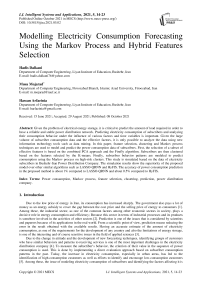Modelling Electricity Consumption Forecasting Using the Markov Process and Hybrid Features Selection
Автор: Hadis Dalkani, Musa Mojarad, Hassan Arfaeinia
Журнал: International Journal of Intelligent Systems and Applications @ijisa
Статья в выпуске: 5 vol.13, 2021 года.
Бесплатный доступ
Given the problem of electrical energy storage, it is critical to predict the amount of load required in order to have a reliable and stable power distribution network. Predicting electricity consumption of subscribers and analyzing their consumption behavior under the influence of various factors and time variables is important. Given the large volume of subscriber consumption data and the effective factors, it is only possible to analyze the data using new information technology tools such as data mining. In this paper, feature selection, clustering and Markov process techniques are used to model and predict the power consumption data of subscribers. First, the selection of a subset of effective features is based on the combined PCA approach and the Firefly algorithm. Subscribers are then clustered based on the features selected by the K-means. Finally, subscriber behavior patterns are modeled to predict consumption using the Markov process on high-risk clusters. This study is simulated based on the data of electricity subscribers in Bushehr-Iran Power Distribution Company. The simulation results show the superiority of the proposed model over other similar algorithms such as LASSO-QRNN and HyFIS. The accuracy of power consumption prediction in the proposed method is about 1% compared to LASSO-QRNN and about 0.5% compared to HyFIS.
Power consumption, Markov process, feature selection, clustering, prediction, power distribution company
Короткий адрес: https://sciup.org/15017753
IDR: 15017753 | DOI: 10.5815/ijisa.2021.05.02
Список литературы Modelling Electricity Consumption Forecasting Using the Markov Process and Hybrid Features Selection
- Munkhammar, J., van der Meer, D., & Widén, J. (2021). Very short-term load forecasting of residential electricity consumption using the Markov-chain mixture distribution (MCM) model. Applied Energy, 282, 116180.
- Kaytez, F., Taplamacioglu, M. C., Cam, E., & Hardalac, F. (2015). Forecasting electricity consumption: A comparison of regression analysis, neural networks and least squares support vector machines. International Journal of Electrical Power & Energy Systems,67, 431-438.
- Rezaeipanah, A., Mojarad, M., & Fakhari, A. (2020). Providing a new approach to increase fault tolerance in cloud computing using fuzzy logic. International Journal of Computers and Applications, 1-9.
- Bianco, V., Manca, O., & Nardini, S. (2009). Electricity consumption forecasting in Italy using linear regression models. Energy, 34(9), 1413-1421.
- Rezaeipanah, A., Matoori, S. S., & Ahmadi, G. (2021). A hybrid algorithm for the university course timetabling problem using the improved parallel genetic algorithm and local search. Applied Intelligence, 51(1), 467-492.
- Mohamed, Z., & Bodger, P. (2005). Forecasting electricity consumption in New Zealand using economic and demographic variables. Energy, 30(10), 1833-1843.
- Devaine, M., Gaillard, P., Goude, Y., & Stoltz, G. (2013). Forecasting electricity consumption by aggregating specialized experts. Machine Learning, 90(2), 231-260.
- Eseye, A. T., Lehtonen, M., Tukia, T., Uimonen, S., & Millar, R. J. (2019, July). Short-term forecasting of electricity consumption in buildings for efficient and optimal distributed energy management. In 2019 IEEE 17th International Conference on Industrial Informatics (INDIN) (Vol. 1, pp. 1103-1110). IEEE.
- Rakhmonov, I., Berdishev, A., Niyozov, N., Muratov, A., & Khaliknazarov, U. (2020, July). Development of a scheme for generating the predicted value of specific electricity consumption. In IOP Conference Series: Materials Science and Engineering (Vol. 883, No. 1, p. 012103). IOP Publishing.
- Ye, Z., & Kim, M. K. (2018). Predicting electricity consumption in a building using an optimized back-propagation and Levenberg–Marquardt back-propagation neural network: Case study of a shopping mall in China. Sustainable Cities and Society, 42, 176-183.
- Rahman, A., Srikumar, V., & Smith, A. D. (2018). Predicting electricity consumption for commercial and residential buildings using deep recurrent neural networks. Applied energy, 212, 372-385.
- Ding, S., Hipel, K. W., & Dang, Y. G. (2018). Forecasting China’s electricity consumption using a new grey prediction model. Energy, 149, 314-328.
- Wu, L., Gao, X., Xiao, Y., Yang, Y., & Chen, X. (2018). Using a novel multi-variable grey model to forecast the electricity consumption of Shandong Province in China. Energy, 157, 327-335.
- Fan, G. F., Wei, X., Li, Y. T., & Hong, W. C. (2020). Forecasting electricity consumption using a novel hybrid model. Sustainable Cities and Society, 61, 102320.
- He, Y., Qin, Y., Wang, S., Wang, X., & Wang, C. (2019). Electricity consumption probability density forecasting method based on LASSO-Quantile Regression Neural Network. Applied energy, 233, 565-575.
- Tang, L., Wang, X., Wang, X., Shao, C., Liu, S., & Tian, S. (2019). Long-term electricity consumption forecasting based on expert prediction and fuzzy Bayesian theory. Energy, 167, 1144-1154.
- Abdi, H., & Williams, L. J. (2010). Principal component analysis. Wiley interdisciplinary reviews: computational statistics, 2(4), 433-459.
- Amit Pandey, Achin Jain,"Comparative Analysis of KNN Algorithm using Various Normalization Techniques", International Journal of Computer Network and Information Security (IJCNIS), Vol.9, No.11, pp.36-42, 2017.DOI: 10.5815/ijcnis.2017.11.04
- Tran Son Hai, Le Hoang Thai, Nguyen Thanh Thuy,"Facial Expression Classification Using Artificial Neural Network and K-Nearest Neighbor", International Journal of Information Technology and Computer Science (IJITCS), vol.7, no.3, pp.27-32, 2015. DOI: 10.5815/ijitcs.2015.03.04
- Saptarsi Goswami, Amlan Chakrabarti,"Feature Selection: A Practitioner View", International Journal of Information Technology and Computer Science (IJITCS), vol.6, no.11, pp.66-77, 2014. DOI: 10.5815/ijitcs.2014.11.10


